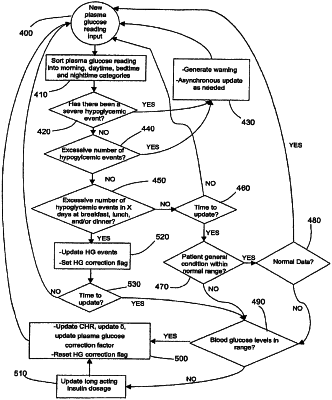| CPC G16H 20/17 (2018.01) [A61B 5/14532 (2013.01); A61M 5/1723 (2013.01); G16H 10/00 (2018.01); G16H 20/10 (2018.01); A61B 5/0002 (2013.01); A61M 5/142 (2013.01)] | 22 Claims |

|
1. A system for monitoring and optimizing a patient's insulin dosage regimen over time, comprising:
at least a first computer-readable memory for storing the patient's data corresponding at least to an initial carbohydrate ratio, an initial long-acting insulin dose, an initial plasma glucose correction factor, and multiple blood-glucose-level measurements determined at a plurality of times;
at least one timer to asynchronously monitor a plurality of predetermined time periods;
a processor operatively connected to the at least first computer-readable memory, the processor programmed to receive data signals from an operatively connected glucose measuring device that at least comprise a patient's blood-glucose-level measurements determined at a plurality of times, wherein the processor:
repeatedly receives blood-glucose-level-measurements of the patient;
automatically evaluates whether the obtained measurements fall within a predefined range;
calculates from the obtained measurements, within a current one of the plurality of predetermined time periods, whether and by how much to vary at least one of the one or more components in the patient's present insulin dosage regimen, with respect to the patient data stored in the at least first computer-readable memory, in order to maintain the patient's future blood-glucose-level measurements within a predetermined range, and so that there is a lower risk of the patient experiencing a hypoglycemic event during subsequent time periods;
send signals to an operatively connected insulin pump once the patient's blood-glucose-level measurements represent a severe hypoglycemic event, the signals instructing the insulin pump to vary at least one of the one or more components in the patient's present insulin dosage regimen; and
sends a control signal to a configurable, interactive display to visually display to the patient the one or more revised components in the patient's insulin dosage regimen, wherein the one or more revised components includes at least an adjusted number of insulin units to be provided to the patient when the obtained blood-glucose-level-measurement of the patient exceeds the predefined threshold; and
wherein the current timer is reinitiated after the determination of whether and by how much to vary at least one of the one or more components in the patient's insulin dosage regimen within the current timer's predefined time period; and
wherein the processor is further programmed to automatically determine from the patient's blood-glucose-level measurements determined at the plurality of times if there have been an excessive number of hypoglycemic events over at least one predetermined time period such that the patient's blood-glucose-level measurements collectively exhibit an abnormal distribution pattern during the course of said period, and to vary at least one of the one or more components in the patient's present insulin dosage regimen in response to said determination;
wherein the processor stores the patient's blood-glucose-measurements associated with hypoglycemic events in a separate, rolling database that stores data for a predefined period of time;
wherein when the insulin dosage regimen is updated, whether in consequence of a periodic update evaluation or an asynchronous update, the current timer is reset;
wherein when a periodic evaluation of the patient insulin dosage regimen is undertaken, for the purpose of calculating whether and by how much to vary at least one of the one or more components in the patient's present insulin dosage regimen, the insulin dosage regimen is treated as having been updated even if there has been no change made to the immediately preceding insulin dosage regimen; and
wherein the processor is connected to a network that is accessible to a healthcare provider and through which data are input and information related to the patient's insulin dosage regimen are communicated.
|